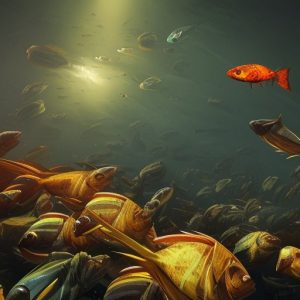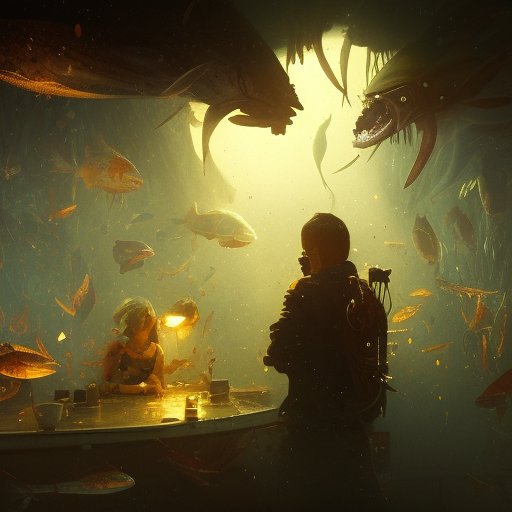
SunGas fish, a genetically modified species created in the labs of the future, is the new culinary sensation. With its vibrant golden scales and succulent flesh, SunGas fish has captured the attention of food critics and chefs alike. However, its commercial harvesting and potential toxicity have raised concerns among scientists and environmentalists. This article explores the genetic engineering and commercial harvesting of SunGas fish and its impact on the economy and ecology. It further delves into alternative methods of sustainable aquaculture and the future of the industry. Is SunGas fish the sustainable food of the future or a ticking time bomb? Read on to find out.
I. Introduction
Welcome, fellow space travelers, to the world of SunGas Fish! This delicacy has been a staple food in our galaxy for many centuries, prized for its unique flavor and cultural significance. Let us take a journey back in time to explore the history and cultural significance of this beloved fish.

Records show that the first sightings of SunGas Fish occurred during the Great Galactic War, where soldiers would venture to the front lines carrying portable tanks filled with the fish as a source of sustenance. Soon after, the culinary world caught onto the trend, and SunGas Fish became a hot commodity.
As the demand grew, the first commercial SunGas Fish farm was established on the planet Vondor. The technology employed was rudimentary, and the process was time and resource-consuming. The harvest was reserved for the elite of society, and an invitation to a SunGas Fish banquet was the pinnacle of social status.
Over time, advancements in space travel and technology led to the discovery and colonization of other planets with environments suitably replicable for the fish. This unlocked a new era of expansion in SunGas Fish farming, resulting in an exponential growth in production and accessibility to the general population.
The cultural significance of SunGas Fish cannot be overstated, as it embodies the heritage and traditions of many civilizations across the galaxy. Planetary feasts, religious ceremonies, and even weddings are incomplete without a dish of SunGas Fish. However, the abundance of this delicacy has led to it losing some of its rarity and status.
Thus, we must ask ourselves, has the commercialization of SunGas Fish diminished its cultural value? Or has it given more people access to a vital and cherished part of our galaxy’s culinary history? This is the question we will explore in the following sections. So sit tight, hold onto your sporks, and let us dive into the world of SunGas Fish!
II. The SunGas Fish’s DNA Sequencing and Genetic Modification
Hold onto your space helmets, readers, as we venture into the scientific realm of SunGas Fish! Genetic modification is a commonplace occurrence in the culinary industry, and SunGas Fish is no exception. The process of genetic modification involves altering the DNA of an organism to enhance desirable traits, such as taste and yield. But how is this done with SunGas Fish?

Firstly, the DNA sequence of the fish is analyzed to identify regions that can be modified to produce the desired results. The process involves isolating the target genes from the genome and transferring them to an ‘expression vector,’ which is essentially a DNA delivery system.
The modified genes are then introduced into the SunGas Fish’s DNA, replacing the original genes. In this way, the fish can produce higher yields, grow faster, or even change color. Genetic modification is a precise process, but it can have unintended consequences as well.
One potential side effect of genetic modification is the vulnerability of SunGas Fish to disease. When modifying the fish’s DNA, the genes governing immune responses could be accidentally altered, leaving them susceptible to infections. Additionally, the genes responsible for taste and texture could also be unintentionally disrupted.
Despite its potential consequences, genetic modification continues to be a leading technology in improving our food sources. We must weigh the benefits against the risks to determine its place in the future of food production.
III. The SunGas Fish’s Commercial Harvesting
As we continue our exploration of SunGas Fish, we must take a closer look at the pros and cons of its commercial harvesting. While commercial harvesting has made this delicacy more readily available and affordable to the populace, it has also raised concerns about sustainability and environmental impact.

One significant advantage of commercial harvesting is the economic boost it provides to the surrounding industries. It creates jobs, increases revenue, and provides a stable source of income for entire communities. Moreover, the availability of this protein-rich food keeps food prices affordable and helps feed hungry mouths across the galaxy.
On the flip side, commercial harvesting has led to overfishing and depletion of the SunGas Fish population. Overfishing could lead to adverse ecological impacts that could span the entire ecosystem. The fish’s crucial role in the food chain may be endangered, impacting other marine life that depends on it for survival.
Another significant issue is the environmental impact of harvesting SunGas Fish. As the demand grows, the manufacturing process becomes more intensive, leading to higher pollution levels in surrounding ecosystems. The increased energy consumption, water utilization, and chemicals used to aid production have led to colossal carbon footprints that impact the entire galaxy’s atmosphere.
IV. SunGas Fish
Ah, SunGas Fish! The jewel of many a fine galactic feast. But what if we told you that this beloved delicacy could also pose a serious health risk?

For some time now, concerns have been raised about the potential toxicity of SunGas Fish. As the fish are known to be predators, they can accumulate various toxins present in their prey, which are then passed onto consumers.
Recent studies have revealed that SunGas Fish contain dangerous levels of cadmium, a heavy metal that can cause serious damage to the kidneys and bones. This has led many to question whether the risks of consuming SunGas Fish outweigh the rewards.
But the harvesting and farming of SunGas Fish is not without its own set of problems. The process requires a significant amount of water and energy, which can lead to environmental damage and pollution. In addition, the widespread use of antibiotics and other chemicals to treat diseases and maintain the health of the fish can further compromise their safety for human consumption.
Many researchers are now exploring alternative methods of SunGas Fish farming that would reduce the risks to both consumers and the environment. Some propose using closed-loop systems that recycle and filter water, while others advocate for the use of algae-based feeds that would eliminate the need for fish-based ingredients.
Despite the potential dangers, the allure of SunGas Fish remains strong. It is up to us, as consumers, to weigh the risks and rewards before indulging in this delicacy. And as we continue to develop and innovate, perhaps we can find a way to make SunGas Fish safe for all to enjoy.
V. The SunGas Fish Industry
Hold onto your neutronium boots, folks, as we take a closer look at the economic and ecological impacts of the SunGas Fish industry. While this delicacy is beloved by many across the galaxy, its production and consumption have far-reaching consequences that must be addressed.

Firstly, the economic benefits of the SunGas Fish industry cannot be ignored. It is one of the most lucrative food industries across the galaxy, providing employment, trade, and revenue to many planets and their inhabitant species. However, the environmental cost of SunGas Fish farming is alarming. The degradation of aquatic ecosystems and water pollution associated with waste products from the industry can have irreversible ecological impacts.
Furthermore, the overfishing of wild SunGas Fish populations, combined with the increasing demand for this delicacy, has led to the depletion of many fish populations. This has pushed scientists and farmers to develop alternative, more sustainable methods of producing SunGas Fish. Aquaculture, for example, offers a solution to these problems, allowing for controlled and monitored breeding while reducing the negative impact on wild populations.
The ecological impacts of SunGas Fish consumption can also be seen in the carbon footprint of the industry. The transportation and storage of the fish, along with its impacted ecosystems, have contributed to a significant amount of carbon emissions. It is crucial to address these concerns by innovating better, more sustainable methods of production and reducing our carbon footprint.
As we move into the future, it is our responsibility to ensure that the SunGas Fish industry’s social, ecological, and economic impacts are considered. While it holds cultural significance and economic benefits, it is essential to ensure that the industry does not harm our planets, aquatic ecosystems, or wild populations. The future of the SunGas Fish industry must prioritize sustainability and innovation to ensure that this beloved delicacy remains a part of our galaxy’s culinary tradition for many generations to come.
VI. Aquaculture of SunGas Fish as a Sustainable Alternative to Wild Harvesting
As the demand for SunGas Fish grew, traditional wild harvesting methods could no longer keep up with the pace. This put a massive strain on the natural populations of the fish, resulting in overfishing and unsustainable practices. It was clear that something had to change. And change it did, with the advent of aquaculture as a viable and sustainable alternative to wild harvesting.

Aquaculture refers to the practice of farming fish in controlled environments. It offers many advantages over traditional harvesting methods, such as reducing the strain on natural populations, better quality control, and greater efficiency. In the case of SunGas Fish, the controlled environment eliminates many of the variables that can affect the quality and taste of the fish.
The process of aquaculture involves breeding the fish in controlled tanks, providing them with the necessary nutrients and environmental conditions to grow, and harvesting them at the appropriate time. The tanks are closely monitored, ensuring that the fish are healthy and well taken care of. Furthermore, waste products from the fish can be reused as fertilizer, reducing the environmental impact of the process.
Aquaculture has also modified SunGas Fish to improve its growth rate, lifespan, and resistance to common diseases. The genetic modification has resulted in hardier, more robust fish that can grow to maturity within a shorter time frame. This leads to greater efficiency and sustainability in the farming process while still maintaining the unique taste and quality of the fish.
Additionally, aquaculture provides a level of control over the fishing cycle that wild harvesting methods cannot offer. Farmers can decide when and how much to harvest, ensuring a sustainable supply for future generations. With an ever-growing population, the switch to aquaculture is imperative for the continued availability of SunGas Fish.
VII. The Future of SunGas Fish
The future is here, fellow space adventurers! We stand on the brink of an entirely new era in SunGas Fish production, one that’s bound to leave you reeling. With the help of biotechnology and genetic engineering, experts have been experimenting with breeding programs to improve the overall quality and accessibility of these fish.

One of the primary areas of focus is the nutritional value of the fish. Scientists are exploring ways to enhance specific nutrients, such as Omega-3 fatty acids, to create a leaner, healthier fish, which could further increase its popularity in the health-conscious era we live in.
Another area of focus is the taste of the fish. Research teams are utilizing genetic manipulation to produce new flavors and textures that have never before been tasted. In the future, one might experience SunGas Fish with hints of honey, or a savory smoky flavor with a subtle kick of spice. The possibilities are almost endless!
Farmers are also exploring new ways to grow the fish sustainably. One such method is vertical farming, where fish are grown in a multi-layered system that enables the efficient use of space and resources. This will increase production on a small scale, allowing for SunGas Fish farms to pop up in the most unlikely places, like the bustling cities of our techno-nexus worlds.
As for the future of the fish itself, recent studies show that it may have profound medical benefits as well. The anti-inflammatory properties of SunGas Fish could prove beneficial in fighting some of the most debilitating diseases in our time. This new development has sparked a renewed interest in the fish, making it a valuable asset in the field of medicine as well.
VIII. Conclusion
And so, we come to the end of our adventure into the world of SunGas Fish. We have explored its history, genetic modification, commercial harvesting, ecological impact, and even its place in our cultural traditions.

Now, we must address the question that has lingered throughout our journey: to eat or not to eat SunGas Fish? The answer, my friends, is not a simple one.
On one hand, SunGas Fish represents a crucial part of our culinary heritage, beloved by many across the galaxy for its unique flavor and cultural significance. It has also become a vital source of income and nutrition for many communities, particularly those in underdeveloped regions.
On the other hand, the commercialization and overfishing of SunGas Fish have led to ecological disasters and the potential toxicity of the fish due to genetic modifications. It has also caused the loss of rarity and exclusivity that once made it a treasured delicacy.
Thus, it falls upon us to strike a balance between our enjoyment of SunGas Fish and responsible environmental practices. Aquaculture and sustainable harvesting methods offer promising solutions to reduce the impact on the ecosystem while still providing access to this cherished delicacy.
It is up to us, as stewards of the galaxy, to decide the fate of SunGas Fish. Will it continue to be a symbol of our cultural heritage, or will it become a cautionary tale of the cost of overconsumption and exploitation? That, my fellow travelers, is for us to decide.
So let us take what we have learned and make informed choices about the food we consume, the environmental impact of our actions, and the importance of preserving the traditions that define us. The journey continues, and the fate of SunGas Fish is in our hands. Live long and prosper, friends!






